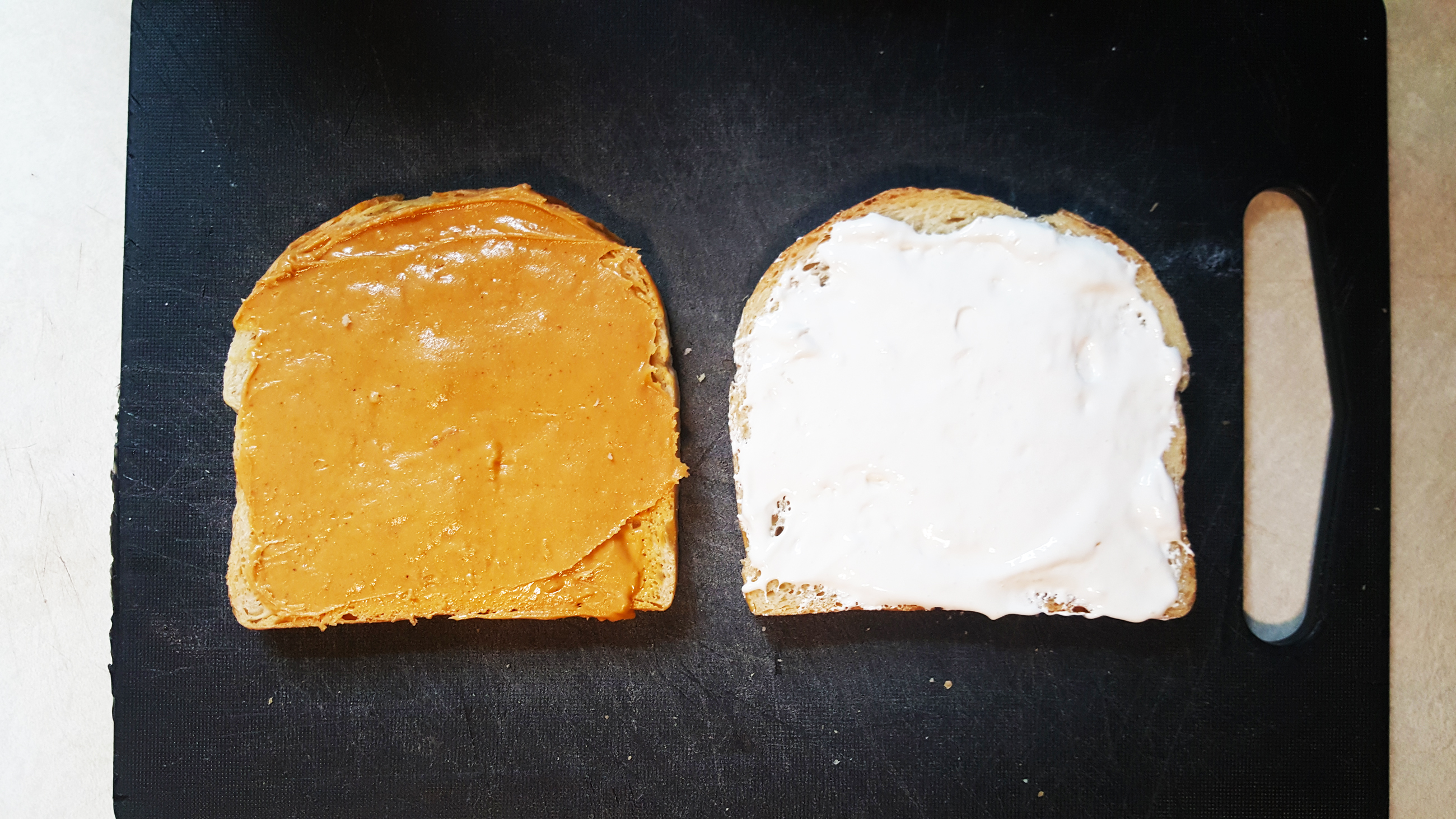French Tartines
Many European countries have their own style of open-faced sandwiches, and the Tribunal has covered many of them in the past: German Butterbrot, Danish Smørrebrød, Czech Obložené Chlebíčky, Polish Kanapki, Spanish Montaditos… Each of these styles reflects the aesthetic of its home country in its range of ingredients and its presentation, from the simple efficiency of the German one-ingredient-and-butter formula to the range of dry-cured hams and pickled vegetables that might be presented on a Spanish Montadito.
One commonality, strange as it seems, are the names of these treats. Butterbrot and Smørrebrød both mean, essentially, buttered bread, and Obložené Chlebíčky means covered bread. Montadito means a small pile or stack, which is cute and introduces a new element, but is not far off from the others. Kanapki is a Polish rendition of the French canapé, the root meaning of which is “sofa,” or an item to lie other things on top of.
The French style of open faced sandwich is called Tartine, which combines the root tarte–pastry–with the diminutive suffix ine, rendering this word which means, essentially, “little pastry.” Whereas other open-faced sandwiches are simply bread adorned with a little butter and some local flair, tartines have higher ambitions. Still, they can be quite simple–bread with butter and jam is a typical breakfast in France; the bread a crusty hunk of baguette or slices from a rustic loaf; the butter cultured, hand-rolled; the jam apricot or fig or strawberry, near to hand and ready to spread. Similarly, the open-faced radish sandwich we wrote about earlier this year–bread, butter, thin-sliced radishes and flaky sea salt–can also be a tartine, especially if the bread is toasted.

Tartines are often served on toasted bread, and reflect French ideas about how to combine flavors: cheeses with fruits, pates with pickles, juxtapositions of salty and sweet, savory and sour, combined in a way that is balanced and beautiful.
I spent some time in my hometown earlier this month, and while I was there I noticed a lox tartine on the breakfast menu of a local sandwich shop called Thyme Station. I hadn’t yet started researching this post but I stopped in to give it a try.


The lox in question was a mild smoked Nova rather than the saltier product that I’ve learned the word lox should indicate–not unexpected, as that usage is common. In other ways, this was very much like a typical bagel-based lox application–toasted sourdough spread with cream cheese, topped with the nova and garnished with capers, thin sliced of picked red onion, and chopped flat leaf parsley.
A Google search for salmon tartine shows me that this is a fairly accurate representation of a common tartine, and I thought it was very well executed. Thyme Station’s bread, in particular, was excellent, though I was unable to acquire a loaf to bring home while I was there. I could have chosen to make my tartines on slices of baguette, but I enjoyed the sourdough so much that I bought a sourdough boule from a store called Mariano’s and used toasted slices of that for all these sandwiches.

My first attempt, inspired by some recipes I found online, and by my continued obsession with pan con tomate, and by what I happened to find in my garden that day (which was a whole big bowl full of little golden grape tomatoes) consisted of a slice of sourdough, scraped with raw garlic, that I spread with chèvre then topped with tiny yellow tomatoes, quartered into wedges. To finish it, I sprinkled on a little flaky sea salt and drizzled extra virgin olive oil infused with garlic and thyme over the top.




How to describe this? It was so delicious, the flavors so vibrant, between the sweetness of the tomatoes and the tartness of the chèvre, the sharpness of the raw garlic and the mellower, toastier flavor of the infused oil–that the light sprinkling of salt, just enough to amplify these flavors, was too much. It was so delicious that it almost hurt to eat it, and my jaw still aches thinking about it days later.
Rillettes
Many of the recipes I read called for pork rillettes, and still others for salmon rillettes. A rillettes is a slow-cooked meat dish similar to confit, where meat is slowly cooked in fat. Unlike confit, the meat is cooked until it is falling apart, then pulled into shreds and mixed with the cooking fat to make a spreadable paste like a pate. I combined features of a few different recipes to make this pork rilletes, which also contains a small amount of duck meat. The aromatic spices, added at the beginning as they are, do not make as much of a difference in the final product as I’d have liked, so consider this recipe a rough draft.
Rillettes
Ingredients
- 3.5 pounds fatty pork butt cut into 1" cubes
- 2 each duck legs about 1 pound
- 35 each black peppercorns
- 20 each coriander seeds
- 10 each allspice berries
- 2 each bay leaves dry
- 2 each sprigs fresh thyme
- 8 each cloves of garlic just barely smashed with the side of a knife
- 1 quart chicken stock
- 2 tsp salt
Instructions
- Grind peppercorns, allspice, and coriander seeds finely
- Place meats in a Dutch oven and mix in spice mixture and salt
- Pour stock over meat mixture. Add garlic, thyme, and bay leaves.
- Gently heat to a simmer on the stovetop while preheating oven to 275° F
- Cover tightly and place in oven for 2.5-3 hours, checking regularly to ensure that the pork doesn't dry out
- When the pork is falling apart and the moisture is almost entirely gone, remove bay leaves, thyme, garlic, and duck legs.
- Drain the pork, reserving the fat. Pull apart into fine shreds. Pull the duck meat apart into fine shreds and mix back into the pork.
- Place in a container and smooth the surface to even. Pour fat over to cover and leave in the fridge for at least 1 day.
Some additional fatback would also help–there was little fat left for covering the rilletes to help preserve it. I guess I’ll just have to eat it quick!
The rillettes tartine I made was a relatively simple one, consisting of a coarse ground Dijon mustard, the rillettes, and pickled onion. There is no significance to the word “ODD” being spelled out twice in pickled onion; I just thought it was funny.



The rillettes could use some salt, and as I mentioned I would like the coriander and allspice aromatics to be more prevalent in the final product, but it’s fine for snacking, soft and savory and easily spreadable, even on a relatively crumbly cracker like a Ritz. Mustard and pickled onion are both excellent foils for the fatty meatiness of the spread, their acidity cutting through while still leaving the rillettes in a starring role.
Cheese and Fruit Tartines
There are a number of ideas out there for tartines involving cheese and fruit, but I saw two main ideas play out repeatedly. The first was a combination of soft, rinded cheeses like Camembert or Brie with fig jam. I chose Brie–Mindy’s favorite, an easy choice to make–with caramelized onions, dollops of fig jam, and walnut halves, toasted under a broiler.




Lesson #1 here was that I should have added the walnuts after toasting it. However, as blackened as they look, they did not have a burnt, acrid flavor but simply tasted even nuttier than usual. The sweetness of both the onions and the fig jam were good complements to the buttery brie, but I couldn’t help thinking that a fruit preserve with more acidity, like raspberry, would have provided a better contrast.
Another common combination I found was Roquefort, or another powerfully-flavored bleu cheese, with sliced pears and honey. These thin slices of Bosc pears were kept in a bowl of water and lemon juice (to prevent enzymatic browning) before being heated in a pan along with a coating of honey and arranged atop the melted Roquefort. The pear slices’ time in the lemon juice water made them more tart than sweet, and I think that additional sweetness would have better contrasted the powerful saltiness of the Roquefort. Still, this was one of the best tartines I made this month.



Winging It
The rules for tantines seem fairly loosely defined, if at all–the bread is toasted, usually; the main ingredient will be some sort of spread, mostly; there will be artfully arranged garnishes that will present a contrasting yet complementary flavor to the main ingredient, probably. It’s more a vibe, an aesthetic to shoot for, than a set of rules. I don’t know if I have it down fully, not really. But I decided to give it a shot.
This is my friend Marinus’ recipe for South African tomato/onion relish that I made for the South African Spatlo post a few weeks ago, sweet and garlicky and redolent of rosemary. I spread it on toasted sourdough and garnished it with leaves of baby arugula, dressed with white wine vinegar and extra virgin olive oil, topped with shavings of Parmesan Reggiano.


Did I manage to capture the tartine vibe? I don’t know. None of these ingredients are particularly French. But the overall combination seemed in the spirit of the sandwich. Besides, it was delicious.

I like sandwiches.
I like a lot of other things too but sandwiches are pretty great












Recent Comments